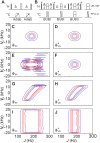Robust bilinear rotations
- PMID: 40880465
- PMCID: PMC12396312
- DOI: 10.1126/sciadv.adx7094
Robust bilinear rotations
Abstract
Bilinear rotation elements allow interaction-dependent manipulations of spins in quantum technologies and, particularly, in spectroscopy. We used bilinear rotation in nuclear magnetic resonance (NMR) spectroscopy and derived several ways of introducing robustness into the filter element. We distinguished two performance levels: the coupling dependent inversion of polarization and the full bilinear π-rotation capability. In addition, all four essential variants of bilinear π rotations-BIRDd, BIRDr, BIRDd,X, and BIRDr,X filters-were given for all cases studied. In the first step, adiabatic CHIRP-type and BUBI/BUBU pulses lead to improved robustness with respect to offset/detuning effects and variations in B1-field strengths. In the second step, we optimized time-optimal coupling-compensated BIRD elements. Together with correspondingly optimized pulse shapes, we established fully coupling, offset, and B1-compensated bilinear π-rotation (COB-BIRD) elements and characterized them in theory and experiment. Overall, this demonstrated the use of the robust bilinear rotation capability on a partially aligned sample in a homodecoupled two-dimensional NMR experiment.
Figures






References
-
- Pfeiffer F., Werninghaus M., Schweizer C., Bruckmoser N., Koch L., Glaser N. J., Huber G. B. P., Bunch D., Haslbeck F. X., Knudsen M., Krylov G., Liegener K., Marx A., Richard L., Romeiro J. H., Roy F. A., Schirk J., Schneider C., Singh M., Södergren L., Tsitsilin I., Wallner F., Riofrío C. A., Filipp S., Efficient decoupling of a nonlinear qubit mode from its environment. Phys. Rev. X 14, 041007 (2024).
-
- A.M. Stephens, A.G. Fowler, L.C.L. Hollenberg, Universal fault tolerant quantum computation on bilinear nearest neighbor arrays. arXiv:quant-ph/0702201 (2008).
-
- Garbow J. R., Weitekamp D. P., Pines A., Bilinear rotation decoupling of homonuclear scalar interactions. Chem. Phys. Lett. 93, 504–509 (1982).
-
- Uhrín D., Liptaj T., Kövér K. E., Modified BIRD pulses and design of heteronuclear pulse sequences. J. Magn. Reson. A 101, 41–46 (1993).
LinkOut - more resources
Full Text Sources
Research Materials
Miscellaneous

